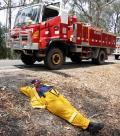An overview of the project Sustained Operations - firefighter health and safety, with Lead End User Robyn Pearce of the Tasmania Fire Service.
Beyond endurance sustaining operations
This research investigated whether shorter, more frequent shifts are a better alternative to regular day and night shift rosters that are currently used by fire and land management agencies in Australia. It was the first study of its kind to evaluate the use of these different shift work systems in a rigorous, controlled environment, using measures relevant to the cognitive demands of incident management and firefighting.
A ‘sustained operations mode’ of work was proposed to manage those operations that demand high cognitive (e.g. incident management teams) and/or high physical (e.g. front line personnel) workloads. This mode of operation divides the day into multiple work and rest cycles, so that individuals can work multiple short shifts (i.e. two X six-hour shifts) intervened by short rests (i.e. six-hour rests) every 24 hours.
The research team developed a testing procedure that evaluated the fatigue and mental performance implications of these shorter, more frequent shifts over a nine-day period.
This research has provided emergency service agencies with the initial data on an alternative to the traditional 12 hours on/12 hours off shift model, in order to manage the fatigue-related risks associated with long deployments.
Anastasi Kosmadopoulos’ postgraduate study at CQUniversity was linked to this project, comparing performance of firefighters during split and consolidated sleep/wake schedules.
Related News
Publications from this Project
Sorry: no publications found for this Project











